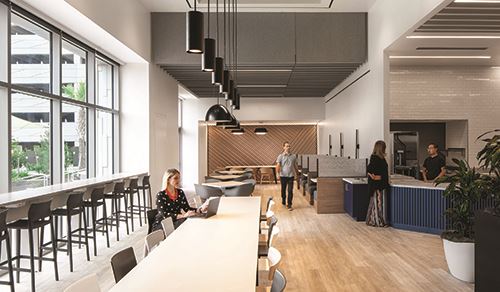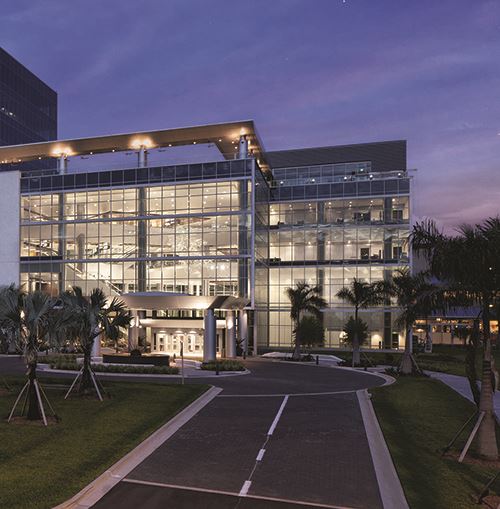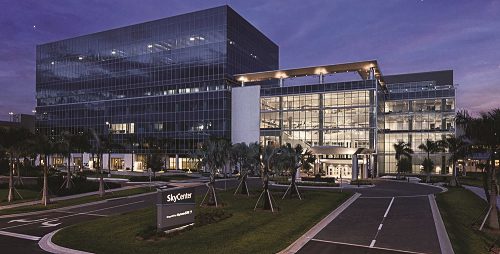Tampa International Airport (TPA) is officially a heavy hitter in the Florida Gulf Coast real estate market. SkyCenter One, a 272,000-square-foot facility on the south side of the airport, contains nine floors: just more than five for commercial leasing, three for airport staff, and ground floor amenities including a café with outdoor seating and a large fitness center for all tenants.
Tampa International Airport (TPA) is officially a heavy hitter in the Florida Gulf Coast real estate market. SkyCenter One, a 272,000-square-foot facility on the south side of the airport, contains nine floors: just more than five for commercial leasing, three for airport staff, and ground floor amenities including a café with outdoor seating and a large fitness center for all tenants. The 35-acre plot where the office building sits also contains space for future commercial development such as a hotel, a convenience store and gas station.
|
facts&figures Project: Commercial Office Building Location: Tampa (FL) Int’l Airport Airport Operator: Hillsborough County Aviation Authority Building Name: SkyCenter One Size: 9 floors; 272,000 sq. ft. Allocations: 3 floors of office space for Aviation Authority; 5+ floors for commercial lease; 1 floor of shared amenities Cost: $122 million Funding: $95 million from private developer; $27 from Aviation Authority Construction: Nov. 2019-June 2021 Private Developer: VanTrust Real Estate Design Lead for Building Core & Shell: HOK Building Core & Shell Construction: J.E. Dunn Design-Builder for Aviation Authority Floors: DPR Construction, with Gensler for design Move Management: Chrysalis Global Aviation Building Features: Fitness center; café with outdoor eating area; conference room; board room; direct access to airport’s automated people mover; connection to 4-story atrium & rooftop terrace; skybridge connection to new consolidated rental car facility; access to multipurpose trail Key Benefits: New consolidated location for Aviation Authority employees; non-aeronautical revenue from commercial leasing after airport purchases building from developer
Initial Revenue Projections: |
The Hillsborough County Aviation Authority (HCAA), which operates TPA, partnered with commercial developer VanTrust Real Estate to design and build the new $122 million structure. VanTrust funded the lion’s share of the project; TPA invested $27 million to add hurricane protections for infrastructure that are crucial for maintaining airport operations. The new office building was completed in June 2021, and employees from 21 Aviation Authority departments moved in earlier this year. Previously, these departments were located in several different locations and buildings throughout the airport campus—an inconvenient arrangement that had evolved over many years at the space-constrained airport.
Currently, the Aviation Authority is the anchor tenant, but it plans to transition to the role of landlord soon. Per its contract with VanTrust, HCAA can buy the building at any time; and it intends to do so in the future. Under this arrangement, the developer assumed the risks associated with designing and building the facility, and the Aviation Authority ultimately ended up with a facility built to meet its specifications that it can lease portions of for additional non-aeronautical revenue. After HCAA purchases SkyCenter One and the property is fully leased, it plans to hire a company to manage the leased portions.
Interrelated Projects
The new office building is part of a three-phase development program outlined in the master plan that HCAA’s board of directors approved in April 2013. Phase One, completed in 2018, created a consolidated Rental Car Center that connects to the Main Terminal via an automated people mover system. Relocating rental car operations during Phase One allowed TPA to expand its main terminal footprint, with additional space for future flexibility and growth. Phase Two, which is currently in progress, includes 16 new express curbsides, expanded roadways and the 35-acre SkyCenter development area. Phase Three will include a new 16-gate airside terminal that will accommodate both domestic and international operations. The plans and timing of Airside D are currently being reevaluated as part of the airport’s 2022 Master Plan Update.
SkyConnect, TPA’s automated people mover system, shuttles passengers to and from the new Rental Car Center, Economy Parking and the Main Terminal. The 1½-mile train ride to the terminal takes about two to three minutes. HCAA Vice President of Planning and Development Jeff Siddle notes that providing train service to and from the new Rental Car Center removed an estimated 3.2 million vehicles from airport roadways and curbsides each year. (Details about the Rental Car Center and train projects were covered in our April 2018 issue.)
 “That’s all part of the initiative to get as many million annual passengers as we can using the current complex,” Siddle notes. The airport has additional space to the north set aside for another terminal development complex in the future. The Aviation Authority will evaluate the needs and timing of such a facility as part of the 2022 Master Plan Update process.
“That’s all part of the initiative to get as many million annual passengers as we can using the current complex,” Siddle notes. The airport has additional space to the north set aside for another terminal development complex in the future. The Aviation Authority will evaluate the needs and timing of such a facility as part of the 2022 Master Plan Update process.
Phase Two improvements, including 16 new express lanes for dropping off and picking up passengers without checked luggage, doubled the airport’s curbside capacity, Siddle reports. “This area has been growing like gangbusters,” he explains. “There’s anywhere from 100 to 150 people moving into the Tampa Bay region per day; so we need to be ready for that in our airport infrastructure.” TPA’s Blue Express Curbsides opened in November 2021 and the Red Express Curbsides are expected to open in 2025. (Details about curbside improvements were covered in our September 2019 issue.)
Development Partners
With no previous experience in commercial real estate, HCAA sought out an industry specialist for the SkyCenter One project. The Authority used a two-part public competitive selection process and ultimately chose VanTrust Real Estate as its developer.

VanTrust designed and built the office building through a collaborative process with the HCAA, and VanTrust is responsible for leasing out the space not occupied by the Aviation Authority. Currently, four floors are leased by J.E. Dunn (the firm that constructed the building), Avison Young (a commercial real estate company), Flad & Associates (an architectural firm), WSP (an engineering firm active in the airport sector), OPSWAT and Simply Healthcare. Tenant improvements were made for initial leaseholders while the building was still being completed. In early April, VanTrust was in ongoing discussions with prospective tenants for the remaining available space.
VanTrust selected HOK to design SkyCenter One and J.E. Dunn to construct it. “It was really a good partnership between their team of consultants, our team of consultants and the Authority’s staff managing the project to make certain that it met all the requirements for years to come,” Siddle remarks.

The SkyCenter Atrium and its commercial curb, completed last summer under a separate contract, heavily influenced HOK’s design for the main structure. The team at HOK wanted the design for the office space portion of the building to look and feel like an extension of the atrium—not as if they were two separate projects with different architects and contractors. “We thought that it was important that there be a cohesive language between the two,” explains Jake Baker, an HOK associate. “So we took the same cladding materials and some of the same lines from the atrium and just extended those into the office building.”
Marc Munago, an executive vice president with VanTrust, compliments the way HOK considered scope and materials to seamlessly incorporate the office building. “SkyCenter One and the atrium are flawlessly joined to form a stunning Class A+ structure, including impressive floor-to-ceiling glass throughout,” he comments.
In addition to HCAA’s Real Estate and Planning and Development departments, other stakeholders such as the Maintenance Department weighed in on the building’s plans as well.
Paradigm Shift
When the design process began on the Authority’s offices in early 2020, the team was operating in a pre-pandemic world. Concepts like working from home, virtual meetings and flexible workspaces had not yet been embraced on a large scale. However, as HCAA and the project team worked remotely to keep the design process moving forward as COVID-19 raged, Avitation Authority officials realized that this new way of work was an opportunity to design its own workspaces differently. “This ultimately resulted in their decision to move away from 1:1 dedicated workstations and allowed them to gain more collaborative and amenity type space,” explains Brian Robbins, the project executive from DPR Construction, which built out the interior of the HCAA floors.
HCAA is shifting from about 40% of its administrative employees in offices to about 15%, adds Senior Manager of TPA’s Office of Innovation Melissa Solberg. This, in turn, reduced the number of workstations needed in its new spaces on Levels 3, 4 and 5 of SkyCenter One. “So not only will the majority of our employees be in an open office environment, but we’ll also be sharing our workstations,” Solberg explains. “That helps us embrace flexible work and the work-from-home mentality.”
Gensler, the firm that designed the HCAA floors within the completed shell, laser-scanned the existing mechanical, electrical and plumbing infrastructure to minimize on-site conflicts. Robbins notes that this proactive approach reduced subsequent design changes and allowed the team to plan for maintenance access to critical equipment.
Features & Amenities

SkyCenter One offered HCAA the opportunity to improve the work experience for its employees, much as it focuses on improving the travel experience for passengers. “As competition for employees heightens, this project will help the HCAA hire, inspire and retain the best talent in the market and industry in support of its goal to be America’s favorite airport,” says Robbins.
Employees and other tenants can take advantage of shared amenities on Level 1, including:
- open work environments
- four-level atrium with outdoor seating areas
- a large conference room and a boardroom-style meeting space
- 3,200-square-foot café with an outdoor eating area
- 6,000-square-foot fitness center with more than three dozen pieces of workout equipment and locker rooms with showers
The building also has access to multipurpose trails that will eventually be connected to Tampa Bay’s regional trails, and a rooftop terrace that is directly accessible from Level 5.
The Aviation Authority’s goal was to develop a Class A+ building with best-in-class amenities for all tenants, including its own employees. Baker notes that the fitness center in SkyCenter One is twice as large as workout facilities in most office buildings, and the service in the café is 10 times better. The new development at TPA is a unique hybrid between a single-tenant headquarters and a multi-tenant building where tenants share and enjoy amenities, he adds.

The atrium has a 650-foot-long covered commercial curb, so passengers can be dropped off, take an elevator or escalator up to the pedestrian bridge with moving walkways, leave their luggage at the remote bag check and ride the SkyConnect train to the terminal. It’s even easier for tenants to catch a flight from work. “You can move from your desk to a terminal without ever stepping outside,” Baker explains. “For a business who relies on travel, the convenience is priceless.”
Sustainable Design
One of the original design requirements for the core and shell of SkyCenter One was to achieve LEED Silver certification; but early in the process, the team decided to aim for LEED Platinum instead. Once certified, this would make it one of only a few Class A Platinum buildings in the region, and the first for TPA.
 Baker explains that HOK took a big-picture approach regarding sustainability, using efficient mechanical systems and high-performance window glazing. Throughout the design process, the team used energy modeling to ensure it was hitting various energy goals. Landscaping around the building uses no potable water, and the garage was designed to accommodate a future solar panel array.
Baker explains that HOK took a big-picture approach regarding sustainability, using efficient mechanical systems and high-performance window glazing. Throughout the design process, the team used energy modeling to ensure it was hitting various energy goals. Landscaping around the building uses no potable water, and the garage was designed to accommodate a future solar panel array.
Construction crews also did their part. “J.E. Dunn did a really great job all the way through,” says Baker, noting that 84% of construction waste from the project was diverted, 43% was recycled content and 63% of the materials came from the local region.
Inside the shell, the three floors occupied by the Aviation Authority were designed and built to LEED Silver standards.

On the Move
Approximately 330 employees from 21 different HCAA departments will work on Levels 3, 4 and 5 of the new office building. That amounts to about half of the Aviation Authority’s total workforce. The other half, mainly maintenance and police teams, moved into a new space outside of the main terminal zone earlier this year.
HCAA assembled a change management team of its own employees to ease the transition and ensure that the airport kept operating efficiently 24/7 during the moves. The team, led by Solberg, includes members from three departments: Planning and Development, Human Resources and Communications. Among other initiatives, the team created an internal blog called TPA on the Move to help keep employees informed about the long, complicated process. Content includes project updates, floor plans, resources for employees and personal interest stories.
 The change management team also collaborated with a core group of leaders who have been working on the SkyCenter One project since the beginning. “This team of 30 leaders, which we affectionately called ‘T-30,’ represented all of the stakeholders that would occupy our new offices,” Solberg explains. During the design process, T-30 solicited feedback from their respective employees to ensure that the new spaces would suit their needs. Now, the group provides similar feedback to the change management team to help ease the transition to the new building.
The change management team also collaborated with a core group of leaders who have been working on the SkyCenter One project since the beginning. “This team of 30 leaders, which we affectionately called ‘T-30,’ represented all of the stakeholders that would occupy our new offices,” Solberg explains. During the design process, T-30 solicited feedback from their respective employees to ensure that the new spaces would suit their needs. Now, the group provides similar feedback to the change management team to help ease the transition to the new building.
DPR Construction and Gensler, the team that built and designed the HCAA spaces, hired Chrysalis Global Aviation to coordinate the physical move from various office locations around the airport into SkyCenter One. The Chrysalis team first came on site in March 2020, initially taking inventory and creating a preliminary move assessment at the 30% design phase. As design and construction of the new offices progressed, Chrysalis personnel continued to update and finalize the inventory. The consultants held coordination meetings with the HCAA change management team on a weekly basis and eventually transitioned to a daily schedule. In January 2022, Chrysalis began coordination and logistics efforts with moving vendor First Class Moving Systems for the March/April 2022 moves.
 Andrew Young with Chrysalis notes the complex move was carefully phased to gradually relocate various departments over the course of about two weeks. The Airport Operations Center will be the last group to move.
Andrew Young with Chrysalis notes the complex move was carefully phased to gradually relocate various departments over the course of about two weeks. The Airport Operations Center will be the last group to move.
Leaving offices they had occupied for decades was an intimidating process for many employees, Robbins remarks. To reduce associated stress, the Authority worked with DPR Construction to coordinate work carefully and communicate a clear picture about future workspaces.
 Scott Vriesman with Chrysalis understands that moving hundreds of employees into new facilities can seem overwhelming, and he consequently emphasizes the need to clearly understand each department’s new footprint and storage capacity. “If you’ve been in a location for several years, you tend to collect things,” Vriesman says, noting the importance of paring down before a move.
Scott Vriesman with Chrysalis understands that moving hundreds of employees into new facilities can seem overwhelming, and he consequently emphasizes the need to clearly understand each department’s new footprint and storage capacity. “If you’ve been in a location for several years, you tend to collect things,” Vriesman says, noting the importance of paring down before a move.
Solberg notes that the combination of an internal change management team and an outside move management consultant was highly effective. The former saved HCAA money and built credibility within the project team; the latter allowed the Aviation Authority and its construction partners to focus on their primary priorities unconstrained by the details and logistics of physically moving personnel and equipment into the new building.
“I think the biggest thing is making sure that you have a change management philosophy in place and that you have a dedicated team to help navigate the way forward,” says Solberg.
Hurdles to Clear
Like the move, design and construction had notable challenges—including a building site located between two active runways. “You can just imagine the level of coordination that was required with the FAA and the airport to make sure that we were building something that wouldn’t impact the surrounding runways,” Baker muses.
Installing cooling towers on the rooftop of the nine-story structure required extra attention because they are inches below the maximum height allowed in that location. “We put the biggest possible building into a really difficult spot, but managed to get it there,” Baker reflects.
Acoustics were also a concern, due to the proximity of aircraft taking off and landing on both sides of the building. The team from HOK helped mitigate the associated noise for tenants when designing the exterior facade and specifying window glazing.

TPA’s 24/7 “nerve center” required extra protection against Florida hurricanes because it includes the Airport Operations Center, Emergency Operations Center, Data Center and associated technology infrastructure, generators and backup generators. “The steel and the tonnage to make it strong enough to withstand those lateral wind pressures goes all the way down to the structure of the building,” Baker remarks.
When specifying windows, the design team worked to balance amazing views of the bay and downtown area while ensuring safety for HCAA personnel who stay on site during storms. Glazing that meets state building code Large Missile Impact Ratings for windborne debris was added to the entire structure to make it safe for those within the building.

Another obvious challenge that arose during the project was COVID-19. Baker credits J.E. Dunn for keeping conditions safe while still completing construction on time. “Frankly, we saw office buildings get put on hold because the pandemic rocked the office markets so much, and the airport didn’t blink,” he recalls. “They didn’t flinch, moved ahead with their vision and ultimately, it paid off.”
On the flip side, less passenger traffic due to the pandemic helped contractors work more efficiently.
Lessons & Opportunities
As HCAA’s vice president of Planning and Development, Siddle reflects positively about the decision to work with an outside developer on SkyCenter One. Constant communication and input from stakeholders helped ensure that the Aviation Authority’s goals blended properly with the goals of VanTrust, he adds. For instance, the building design needed to meet HCAA’s needs, because it would be the primary tenant. “Once we understood each other’s goals and objectives, everybody partnered on it,” he says. “That was a good success story.”
 Speaking from the developer’s perspective, Munago agrees—and stresses the opportunities for increasing non-aeronautical revenue at TPA. “The decision to partner with an experienced developer gives the Airport Authority the opportunity to collaboratively work through the process of achieving their goals without taking on a project that is beyond their area of expertise,” he reasons.
Speaking from the developer’s perspective, Munago agrees—and stresses the opportunities for increasing non-aeronautical revenue at TPA. “The decision to partner with an experienced developer gives the Airport Authority the opportunity to collaboratively work through the process of achieving their goals without taking on a project that is beyond their area of expertise,” he reasons.
HOK’s Baker notes that teaming up with an outside developer helped the Aviation Authority understand the real estate market and what tenants are willing to pay. It was valuable to bring in a partner that routinely works on commercial office space to help create what is best for the airport—while keeping potential tenants for the rest of the building in mind, he adds.
Baker also credits HCAA for its big-picture planning regarding the new development. By moving the Operations Center out of the main terminal, it allowed for additional passenger-focused development. “I commend them for the way that they’ve master planned their full airport, being forward-minded and looking at how to bring in tenants and how to make it more than just an internalized airport,” he elaborates. “It’s great to see an airport focus on how it integrates and contributes to its community, rather than being an island within the city.”
After the move to SkyCenter One is well behind TPA, Solberg looks forward to sharing the experience with other airports and entities outside the industry. “We’ll bring people through the space, tell them what works, what doesn’t and just help others learn from the project process we’ve gone through,” she remarks.



